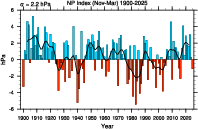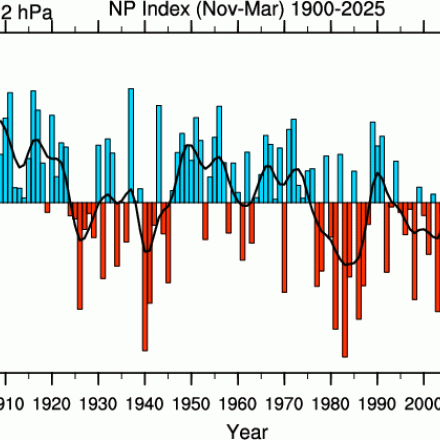North Pacific (NP) Index by Trenberth and Hurrell; monthly and winter

The North Pacific Index (NP index or NPI) is the area-weighted sea level pressure over the region 30°N-65°N, 160°E-140°W. The NP index is defined to measure interannual to decadal variations in the atmospheric circulation. The dominant atmosphere-ocean relation in the North Pacific is one where atmospheric changes lead changes in sea surface temperatures by one to two months. However, strong ties exist with events in the tropical Pacific, with changes in tropical Pacific SSTs leading SSTs in the north Pacific by three months.
Key Strengths
Long timeseries running from 1899 to present.
Depicts changes in the intensity of the Aleutian low, and is highly correlated with the 500hPa PNA index from Wallace and Gutzler (1981).
Official North Pacific Index cited in Trenberth & Hurrell (1994).
- North Pacific Index (monthly)
Missing Value
-999Units
hPaUpdated Through
2025-03-31Next Update
2026-05-01Start Date
1899-01-01File Notes
CAS Citation
NP Index Data provided by the Climate Analysis Section, NCAR, Boulder, USA, Trenberth and Hurrell (1994). Updated Regularly. Accessed DD Month YYYY [list date you accessed the data]. - North Pacific Index (NDJFM)
Missing Value
-999Units
hPaUpdated Through
2025-03-31Next Update
2026-05-01Start Date
1899-01-01File Notes
NDJFM North Pacific Indices: The station index value for year N refers to an average of November and December year N-1 and January, February, and March year N. (Example: The 1999 value contains the average of November and December 1998 and January, February, and March 1999.)CAS Citation
NP Index Data provided by the Climate Analysis Section, NCAR, Boulder, USA, Trenberth and Hurrell (1994). Updated Regularly. Accessed DD Month YYYY [list date you accessed the data]. - North Pacific Index Anomalies (NDJFM)
Missing Value
-999Units
hPaUpdated Through
2025-03-31Next Update
2026-05-01Start Date
1899-01-01File Notes
NDJFM North Pacific Index anomalies based on 1925-1989 mean of 1008.9 hPa NDJFM North Pacific Indices: The station index value for year N refers to an average of November and December year N-1 and January, February, and March year N. (Example: The 1999 value contains the average of November and December 1998 and January, February, and March 1999.)CAS Citation
NP Index Data provided by the Climate Analysis Section, NCAR, Boulder, USA, Trenberth and Hurrell (1994). Updated Regularly. Accessed DD Month YYYY [list date you accessed the data].
Cite this page
Acknowledgement of any material taken from or knowledge gained from this page is appreciated:
Hurrell, James &, Phillips, Adam & National Center for Atmospheric Research Staff (Eds). Last modified "The Climate Data Guide: North Pacific (NP) Index by Trenberth and Hurrell; monthly and winter.” Retrieved from https://climatedataguide.ucar.edu/climate-data/north-pacific-np-index-trenberth-and-hurrell-monthly-and-winter on 2025-12-17.
Citation of datasets is separate and should be done according to the data providers' instructions. If known to us, data citation instructions are given in the Data Access section, above.
Acknowledgement of the Climate Data Guide project is also appreciated:
Schneider, D. P., C. Deser, J. Fasullo, and K. E. Trenberth, 2013: Climate Data Guide Spurs Discovery and Understanding. Eos Trans. AGU, 94, 121–122, https://doi.org/10.1002/2013eo130001
